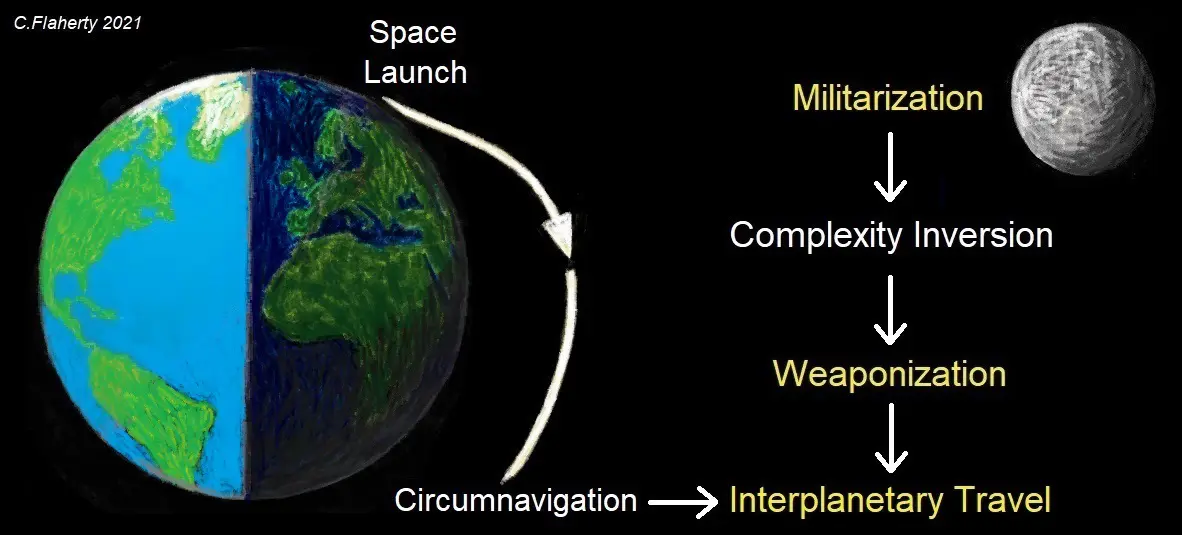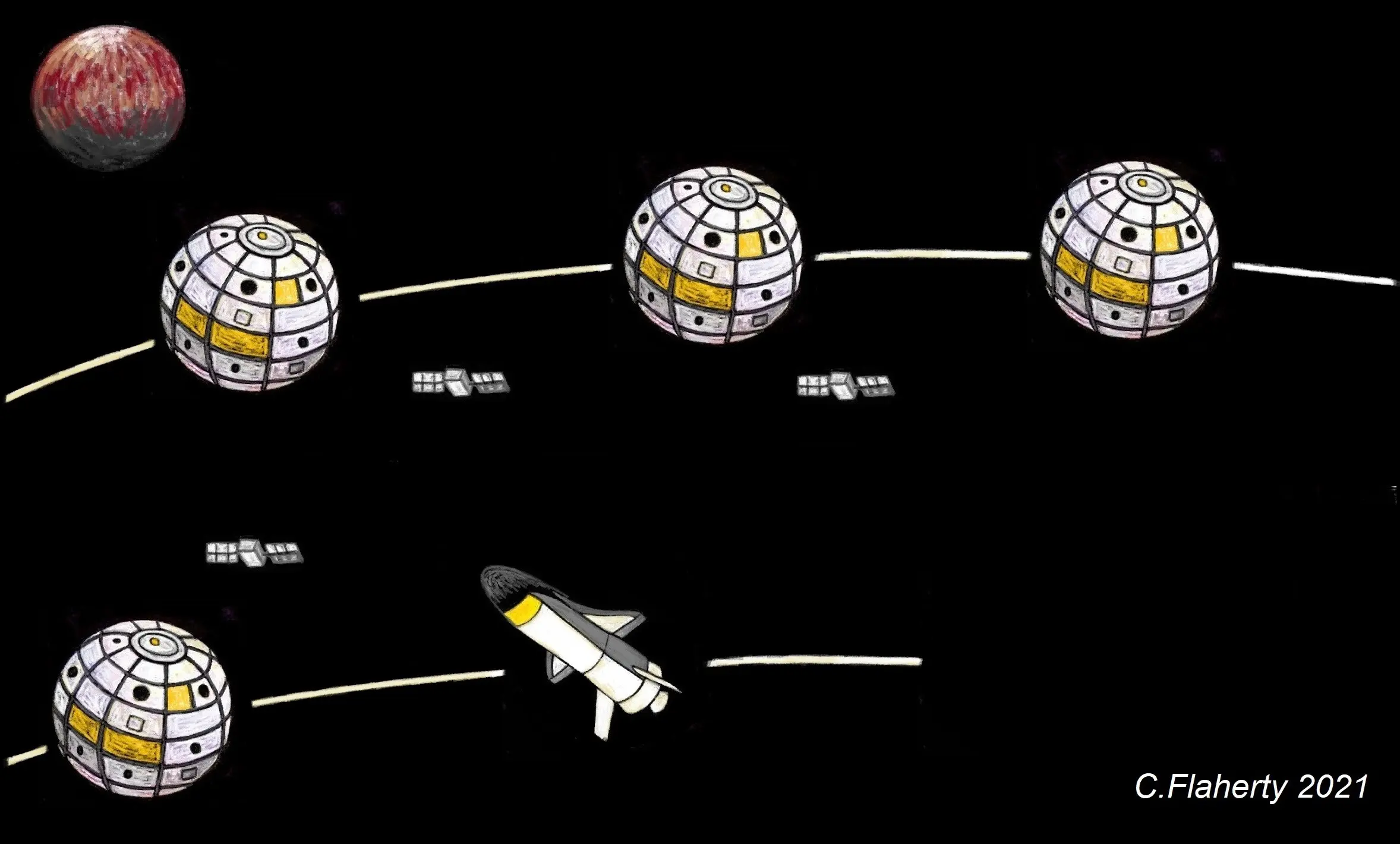
By Chris Flaherty
my Space Warfare Analysis Lab
INTRODUCTION
This short exploratory paper will look at how Manoeuvre figures in Space Warfare. The changing nature of Space Warfare Manoeuvre and the Post-WW2 Space Warfare Era are fundamentally tied to a series of radical technology shifts, that becomes more radical in relation to the ability to put a Spacecraft-Satellite into Space, and to move it from one point to another. The Space Warfare Era begins with the ability to circumnavigate the Earth. The next step – which is currently occurring – is the ability to achieve interplanetary travel. Underpinning this historical-technological shift is a transitional-flip from:

A transitional-flip from global strategy to solar system strategy, mirrors the expansion of the globalized economy into Space, and the setup of a solar system economy; all of which is a product of the ability to build an interplanetary travelling Spacecraft. The shift in Space technology has itself been gaining pace. A driver has been, “Complexity Inversion” (Gould, 1978). Originally conceived in relation to creating a Space-based information infrastructure, the notion is equally germane to Space Warfare in relation to the possibilities of Manoeuvre. Parallel to the technology shift two polar strategies have largely operated represented by the Militarization, or Weaponization of Space (Harrison, 2021). The end of this paper looks at a Battle Orbit exhibiting a new type of linear Manoeuvre in Space Warfare.
SPACE MILITARIZATION AND WEAPONIZATION STRATEGIES

FIGURE 1: Illustrates a process of historically expanding concept of Manoeuvre in Space Warfare. Beginning with launching into Space, and the ability to circumnavigate the Earth, this technology creates new Manoeuvre opportunities in terrestrial-based warfare (its Space Militarization Polar Strategy Phase). A radical flip in the means to warfight brought about by Complexity Inversion, sees a transition from Spacecraft-Satellites able to circumnavigate the Earth to interplanetary Spacecraft. Along with this, the Weaponization of Space Polar Strategy Phase, creates new concepts of Manoeuvre in Space Warfare.
Captain Ramius: “It reminds me of the heady days of Sputnik and Yuri Gagarin when the world trembled at the sound of our rockets.” (Paramount Pictures, 1990)
A progressive-to-radical flip brought about by Complexity Inversion of military forces, will see rocket launching become synonymous with Manoeuvre in Space Warfare. Since the beginning of the Space Warfare Era, the meaning and significance of Manoeuvre have evolved. Part of that change has been technological shift, but it has also been the establishment of two polar strategy opposites: Militarization, or Weaponization of Space.
The first phase in the evolution in Space Warfare is represented by one of the polar-strategy: the Militarization of Space; denoting its passive use of Space-based systems to support military planning and operations on Earth (Harrison, 2021). Space Militarization represents one rubric of Manoeuvre – its terrestrial-based form. The second phase of Space Warfare evolution is brought about by a radical flip towards Complexity Inversion where initially the bulk of a system at its Space-End is small and light. The corresponding ground segments are massive and complex. Advances in technology, and keeping within reasonable launch cost limitations, the reverse of this situation becomes feasible to make the Space segment vastly more capable and complex (Gould, 1978).
Launching into Geostationary Orbit, and the ability for a Spacecraft-Satellite to circumnavigate the Earth (Clarke, 1945; 1945), has been largely characterized as the high ground of Space (discussed in more detail below). Described as, “[the]… present age of Astrostrategy … [this]… remains for the most part concerned with satellites.” (Stevenson, 2021) This characterization effectively segue into expanding the horizon of the communications, navigation (global positioning), surveillance, reconnaissance, and meteorological information spheres of warfare, and the ability to increase the precision and Manoeuvrability of a terrestrial-based force. In the context of the 1991 Persian Gulf War it was declared by the Air Force Chief of Staff Merrill A. ‘Tony’ McPeak, “the First Space War.” (Covault, 1991; Bruger, 1995)
The following sections of this exploratory paper will look at several issues surrounding the changing notion of Manoeuvre in Space Warfare. This will begin with a discussion about the concept of the Space High Ground and its relationship to Constrained Manoeuvre in Space. This is followed by looking at Orbital Manoeuvre, and Geostationary Orbit. The next section will look at Complexity Inversion. The paper then looks at Battle Orbits, and how a Space Battle could be fought between two fleets of interplanetary travelling Spacecraft-Warships. The final part of this paper looks at Space Transit Lines.
SPACE HIGH GROUND AND CONSTRAINED MANOEUVRE
In the 1991 Persian Gulf War, the notion of Space-based Manoeuvre was expressed in two ways. The first of these was Inter- and Intra-Theatre, and over-the-horizon satellite communications, representing one of the possible directions of Space Warfare, that it permitted Manoeuvring of terrestrial-based forces (Bruger, 1995). Historically, the major advance was that Satellite-Based Global Positioning Systems, and navigation allowed ground forces to Manoeuvre during the 1991 War (Greenemeier, 2016). This in effect mirrors the traditional conception of terrestrial-based Manoeuvre:
“Place the enemy in a position of disadvantage through the flexible application of combat power.” (Szymanski, 2019)
Enabling terrestrial-based Manoeuvre, in this case relates to, “a military axiom to take the high ground – and Space is the ultimate high ground.” (Bruger, 1995)
“Among the missions weather satellites supported were strike planning, redirection, weapons loading, air refuelling, and displaying flood plains. These were vital to Gen. H. Norman Schwarzkopf. His ‘Hail Mary’ Manoeuvre succeeded because the general knew the weather and was able to move his tanks effectively.” (Kutyna, 1995)
In regards to earlier Space Warfare visions, as far-back as the mid-1950s, such as a Space Bomber’s ability to circumnavigating the Earth, have been linked to the notion of control of high ground, even the ability to have a Lunar Base has been cast in terms of the same high ground concept (Boushey, 1958; Sambaluk, 2011). Additionally, parallel to the high ground there was also Space Manoeuvre of a Spacecraft-Satellite. In the case of the 1991 Persian Gulf War, a Defense Satellite Communications System craft,
“was moved from its geosynchronous Pacific Ocean orbit to the Indian Ocean, where it supplemented two … [others]… one already over the Indian Ocean and one above the Atlantic Ocean.” (Bruger, 1995)
As a fundamental, rocket launching a Spacecraft-Satellite is itself Manoeuvre from the terrestrial surface into Low Earth Orbit, or further into Cislunar and Mars Space. This can potentially be a new type of Space Warfare Manoeuvre.
Constrained Manoeuvre
In its current form, Manoeuvre in Space Warfare is constrained in one of several ways. These are largely contained in the following set of evolving concepts and relationships (illustrated in FIGURE 2). Constrained Manoeuvre can either be defined by the constraints in Space found in orbit-shift of a Spacecraft-Satellite, or in Orbital Manoeuvre itself. Constrained, Orbital Manoeuvre, or Geostationary Orbit essentially enable terrestrial-based Manoeuvre. Whereas, Orbital Manoeuvre, through Complexity Inversion, and the ability to build an interplanetary travelling Spacecraft, ultimately leads to interplanetary travel – Manoeuvre, which relates to Space Transit Lines (discussed at the end of this exploratory paper).

FIGURE 2: The relationships between Constrained Manoeuvre, Orbital Manoeuvre, Geostationary Orbit, terrestrial-based Manoeuvre, and interplanetary travel – Manoeuvre.
Case-study assessments of the actual technology of Space-to-Space Battle, or War using a kinetic attack by a Spacecraft-Satellite illustrates typical Space constraints. The study shows an orbit-shift of a Spacecraft-Satellite would be heavily constrained by the limits physics imposes on movement in Space, and the limitations imposed by time:
“[requiring]… deliberate … [planning]… with satellites Manoeuvring for days, if not weeks or months, beforehand to get into position to have meaningful operational effects. But once an orbital threat has matched planes and set-up the timing through precise orbital phasing, many opportunities can arise to Manoeuvre close enough to engage a target quickly.” (Reesman, 2020)
Further still, in relation to Space-based Manoeuvre other notional constraints operate, such as: optimal positions and time-space phasing; or, critical orbits, launch corridors, and communications paths around the world (Szymanski, 2019). While beyond the scope of this exploratory paper – Space Manoeuvre constraints also sit within an overall framework of access to Space denial to the adversary, and maximizing freedom of action (Szymanski, 2019; U.S. Space Force, 2020).
A variation on Constrained, and Orbital Manoeuvre, and ultimately the Space Transit Line (discussed later in this exploratory paper), is the problem of Space traffic considerations. Spacecraft-Satellites essentially crowd popular orbital slots (Samson, 2021). The problem is currently confined to Low Earth Orbit, however, as interplanetary travel becomes a permanent activity, it is expected to extend along favoured orbital – flight paths (Space Transit Lines). For instance, if an entity such as a state, or commercial enterprise was to place a huge number of Spacecraft-Satellites along a particular orbital slot, “[this]… essentially cedes that orbit to that … [entity]” (Samson, 2021). Further, there is the considerable problem of Earth’s Spacecraft-Satellite layer already-crowded orbits being cluttered with dead and defunct craft, and debris. The presence of these objects fundamentally constrains Manoeuvre opportunities within an orbit, or moving to another one, in the case of rendezvous and proximity operations between two Spacecraft-Satellites. It is also possible to conceive of a future strategic-tactical advantage in having old Spacecraft-Satellites used as decoys, and cover for other craft in order to increase Deception and Manoeuvre opportunities by two adversaries in a Space-to-Space Battle.
ORBITAL MANOEUVRE AND GEOSTATIONARY ORBIT
A Spacecraft-Satellite appearing to an observer in a fixed position in the sky – in Geostationary Orbit is another form of Constrained Manoeuvre. Orbital Manoeuvre (is also largely defined in relation to its constraints):
“Constrained freedom of Manoeuvre is a defining attribute of Space Operations. Due to orbital mechanics, objects in orbit persist in a state of perpetual motion. Just as impactful is the significant energy required to reach orbital altitudes and to Manoeuvre into a different orbit. Due to extreme velocities, the amount of energy required to reach a different orbit may be significant enough to render the option unfeasible or impractical.” (U.S. Space Force, 2020)
The Spacecraft-Satellite in constant movement that cannot be stopped is a radically different notion to that of traditional military Manoeuvre, as is the notion that places a military force located on a planet spinning on its own axis. Applying this principle to Orbital Manoeuvre:
“the physical nature of satellite orbits implies a scope outside the realm of a Theatre-focused component commander. For example … [Low Earth Orbit] … satellites … that circle the globe every ninety minutes, can support more than just one commander or user at a time – they are truly national assets.” (Bruger, 1995)
Two concepts that have influenced terrestrial-based warfare are the modes: Manoeuvre and Static. In the Space environment this changes – all is in movement.
Reconceptualization of the Satellite as the current Spacecraft composing Space Fleets (U.S. Space Force, 2020); begins a technology process shifting emphasis from enabling terrestrial-based forces Manoeuvre to, “Manoeuvre … [as]… an operational tactic that can be used by satellites” (Harrison, 2021). Its beginning point is Human evolution on the terrestrial surface. Evolving in an environment where a Human standing still experiences motionless phenomenon, and the world around them is where other people, animals are moving, objects are propelled and the Sun, Moon and Stars rise and set. The radical conceptual shift, is the perception of all is in motion. The Earth is in rotation on its axis, its Moon, and satellites are in orbit around the Earth, and this orbital system is itself in orbit, around the Sun. A Spacecraft-Satellite launched from Earth takes a flight path that goes into orbit. The only equivalent notion of a static mode in Space Warfare is where a Spacecraft-Satellite appears to an observer in a fixed position in the sky – in Geostationary Orbit, and Earth-based satellite antennas are pointed permanently at the position in the sky where the satellites are located. A major proposition in Space Warfare Manoeuvre is the notion of a Geostationary Orbit relationship between a Spacecraft-Satellite and the corresponding section of the terrestrial surface treated as ‘one Theatre’. Usually covered by its conventional definition,
“[are its]… geographic bounds … extend to include the Space forces … [and their use from Space immediately brings these]… in Theatre and legitimate targets … [by an opponent]” (Preston, 2002).
The alternative is an emphasis on the revolving nature, and separation of the Space domain from the terrestrial domain. This can be conceptualized as a process of Theatre Separation (Flaherty, 2020). This occurring, as orbit speed is greater than the Earth’s rotation, which represents a different view of the conventional definition of a Theatre, when Space-based forces are added into the mix.
Space-based weapons, and terrestrial-based forces have traditionally been viewed part of coordinated, and sequenced actions by diverse components set by a specific geographical context, underpinning the political aims of the conflict (Preston, 2002). Notionally, the Theatre is a geographical location where terrestrial-based forces are available, or must be relocated to; and where Space-based weapons are brought to bear. This gives way to the notion of a constantly revolving planet, around which there are faster orbiting Space-based forces that can attack targets in Space, in the Earth’s atmosphere, or on its surface (as these come overhead, and come into attack range). It can also be anticipated that in order to defend a portion of the Earth’s surface, it does not necessarily mean that the forces needed to do so, are located on the surface. Instead these could operate at extreme high-altitudes, or operate from Space. The object being to attack targets above from Low Earth Orbit, or further out in Space.
COMPLEXITY INVERSION
The last 30 years (1991 till 2021) have seen a process of historically expanding concept of Manoeuvre in Space Warfare (see FIGURE 1). Beginning with launching into Space, and the ability to circumnavigate the Earth this technology creates new Manoeuvre opportunities in terrestrial-based warfare (its Space Militarization Polar Strategy Phase). A radical flip brought about by the Complexity Inversion of the means to warfight, creates an alternative Weaponization of Space Polar Strategy Phase, which also creates new concepts of Manoeuvre in Space Warfare. This runs parallel to a radical shift from the ability to circumnavigate the Earth, to interplanetary travel. The latter, is part of a fundamental transition from the current Space Fleet that use Spacecraft-Satellites that have relatively limited Delta-V, to interplanetary Spacecraft that have large Delta-V capacity (discussed later in this paper).
In terms of transitional-flip from global strategy to solar system strategy, it represents passing beyond Earth’s Spacecraft-Satellite layer in Low Earth Orbit, into Cislunar, and the Space expanse in the solar system (Dolman, 2002; Stevenson, 2021). Taking the example of a terrestrial surface warship, this craft relies on Spacecraft-Satellites for its passive military support in the form of its communications, navigation (global positioning), surveillance, reconnaissance, and meteorological information support. This collective set of military systems at the Space-End are in comparison to the terrestrial surface warship relatively small and light. Even if the rocket launch system used to get the Spacecraft-Satellites into Earth orbit are added into the equation when compared to a current aircraft carrier, destroyer, frigate or submarine.
As stated, the current Space Fleet are in effect Satellites – the current Spacecraft. If these craft grow in size and complexity, become Human and Robotically crewed, and capable of inter-planetary travel, and comparable to the current SpaceX Starship prototype, this will radically flip the current Space Fleet architecture. We can imagine now, a Spacecraft-Warship comparable to a navy corvette. For instance, the SpaceX Starship prototype is envisaged to have a length of 50 meters: 160 feet, with a diameter of 9 meters: 30 feet, and have a gross weight of 1,455 tons, even a similar crew complement (SpaceX). Whereas, the International Space Station (ISS), still technically a Spacecraft, has a weight of some 462 tons, with a crew of seven. Both examples illustrate, a Spacecraft-Satellite and an interplanetary Spacecraft of similar dimensions to a current large navy patrol boat, or a navy corvette.
A radical flip brought about by the Complexity Inversion of the means to warfight – the Weaponization of Space Polar Strategy Phase, creates new concepts of Manoeuvre in Space Warfare. As does a radical technology shift from the ability to circumnavigate the Earth, to interplanetary travel further changes the notion of Space Warfare Manoeuvre, and this takes a particular form when a battle between two Space Fleets is imagined. The next part of this exploratory paper will look at the notion of Battle Orbits, and how a Space Battle could be fought between two fleets of interplanetary travelling Spacecraft-Warships.
BATTLE ORBITS
A Battle Orbit is a notional construct. It imagines a linear formation adopted by two imagined Space Fleets of interplanetary Spacecraft-Warships travelling along an orbital – flight path. This could be one fleet, travelling after an enemy fleet, catching up with it. It could be two fleets travelling towards each other, one coming from the Earth, or its Moon, the other coming from Mars. Essentially one fleet is attempting to interdict the other. In all these examples, the question is what form this could take, as Spacecraft-Warships close-in preparing to engage in battle. It can be argued that in order to maximise efficiency of the Space Fleet’s orbital – flight path, the Spacecraft-Warships would likely follow each other in a traditional line of battle (see FIGURE 3). Even though each craft is capable of omnidirectional weapons use, it can be imagined that these will use line-following order of battle as each craft has to reserve its fuel.
Orbital – Flight Path and Delta-V
The science fiction vision of a battle in Space, has Manoeuvre as its central motif, where fleets of Spacecraft-Warships in various block formations form-up. The trope largely runs counter to the true propulsion and momentum constraints on a Spacecraft. As a basic rule – a Spacecraft is not able to stand-still in Space unless it uses its engines to slow its speed along its orbital – flight path. For instance, momentum will continue to carry a craft forward indefinitely at a constant speed after the engines are turned-off along its orbital – flight path. This is,
“because objects in Space encounter negligible drag, Spacecraft can maintain extreme velocity without propulsion, enabling them to complete an Earth orbit in as little as 90 minutes depending on orbital altitude.” (U.S. Space Force, 2020)
An interplanetary Spacecraft can rely on the gravity-assist it receives from a fly-by of another planet or moon, to shape its next orbital – flight path. Like a Spacecraft-Satellite, an interplanetary Spacecraft is always orbiting something. Its orbital – flight path is only effected by disturbances it encounters in Space, such as the pressure of sunlight on the hull over time pushing the Spacecraft off its course. For an interplanetary Spacecraft, its course is mostly set once the main engine burn is completed. Along its orbital – flight path it can make small corrections in its trajectory by firing small engines or thrusters.
Interplanetary Spacecraft Manoeuvre is largely a function of its access to, “manoeuvring fuel prior to … [a]… Space conflict” (Szymanski, 2019). The magnitude of a craft’s velocity change, provided by its onboard propellants, is known as Delta-V and is measured in meters-per-second (Reesman, 2020). Delta-V stands for change in velocity, representing the direction and magnitude of the required change in the Spacecraft velocity which must be accomplished to get it back on course – which is expressed in terms of the amount of time required for an engine to be fired and produce thrust. A Spacecraft’s total Delta-V capability is constrained by the amount of propellant it can carry. If it drifts from its reference trajectory (effected by disturbances it encounters in Space), a Manoeuvre is needed to get it back on course. Delta-V is the measure of the energy needed to transfer from one orbit to another. Any Manoeuvre in Space is measured by the amount of velocity change required.
SPACE BATTLE
Space Battle is fundamentally constrained by the Spacecraft-Warships’ Delta-V capability and its conservation, and relying on momentum in Space along an orbital – flight path. As stated earlier, a sub-set of Orbital Manoeuvre leads to interplanetary travel – Manoeuvre. Related to this, are the formation of Battle Orbits. This section will look at how a Space Battle could be fought between two fleets of interplanetary travelling Spacecraft-Warships.
FIGURE 3: In the imagined Space Battle each Spacecraft-Warship has protective satellites (kill vehicles). The first Space Fleet is shown catching up to the other, in a Battle Orbit. A tailing Spacecraft-Warship in the second Space Fleet Manoeuvres to interdict the lead enemy craft. Combat between it, and another Spacecraft-Warship has to be envisaged as an attack coming from any direction, and at great distances. For instance, imagine a scenario where two Spacecraft-Warship on different orbital – flight paths within range, fire their weapons at each other. One would manoeuvre in relation to the other, by changing its orbital – flight path, using an adjustment burn of its engines, to avoid being hit by a laser, or a projectile. It might also use smaller kill vehicle satellites to attack or defend with.

FIGURE 3: Illustrates two Space Fleets, following their orbital – flight paths. Each Spacecraft have protective kill vehicle satellites. The first Space Fleet is catching up to the other, in a Battle Orbit, a tailing Spacecraft in the second Space Fleet begins a Manoeuvre to interdict the lead Spacecraft.
SPACE TRANSIT LINES
The notion of a Battle Orbit, has been posited in this exploratory paper to look at how two Space Fleets might fight a battle. Such a linear Manoeuvre concept is largely prefigured by a interplanetary travel – Manoeuvre, and how this relates to Space Transit Lines. It has largely been anticipated that there will be a future economic, and military dependency on, “lanes of commerce and military lines of communications in Space” (Dolman, 2002). Space Transit Lines, consisting of economic lanes and military lines, are crucially connected, “[to]… Hohmann transfer orbits between stable Spaceports.” (Dolman, 2002) In orbital mechanics, the Hohmann transfer orbits: an elliptical orbit used by a craft to transfer between two circular orbits of different radii around a central body in the same plane. The Hohmann transfer often uses the lowest possible amount of propellant in traveling between orbits. This is,
“because of gravity wells and the forbidding cost of getting fuel to orbit, over time Spacefaring nations will develop specific pathways of heaviest traffic. Each of these pathways, identified later in the Astropolitical model as Hohmann transfer orbits, can be shown to have or to be in themselves critical chokepoints. The state that most efficiently occupies or controls these positions can ensure for itself domination of Space commerce and, ultimately, terrestrial politics.” (Dolman, 2002)
Economic, and Military lanes and lines all feed into a broader construct involving the gravity wells – the Earth, its Moon, and Mars. Notionally called, the: “3-Body Effects” (Buehler, 2021). It is based on the concept,
“[that]… emphasizes orbits, regions of Space, and launch points as geopolitically vital assets over which states can be expected competitively and strategically to struggle for control.” (Havercroft, 2009)
Significantly, the only variation to the Space strategic model, is one of the emerging strategic points in the solar system – the Lagrange Points. These are positions in Space where objects sent there tend to stay put. At Lagrange Points, the gravitational pull of two large masses precisely equals the centripetal force required for a small object to move with them. These points in Space can be used by Spacecraft to reduce fuel consumption needed to remain in position (NASA). In regards to the known Lagrange Points (designated L1-5), so far:
“China found the L2 Lagrange Point useful for its Queqiao satellite, which provides continuous relay communications between Earth and the lander on the far side of the Moon. The L4 and L5 Lagrange Points, along the route of the Moon’s orbit of the Earth, are more stable and may be just as valuable to occupy. The same is true of Lagrange Points between the Earth and the Sun.” (Stevenson, 2021)
The notion of Manoeuvre in an imagined battle between two Space Fleets, can be envisaged as a type of speed-way track race, where a line of Spacecraft-Warships, on one speed-way track catches-up with its opponent (which is on another). Depending on the speed of the craft achieved by rocket burns, or by momentum one line of craft will catch-up, or interdict the other line discharging its weapons, destroying the other line as it flies past. This is a form of largely linear Manoeuvre battle in Space, between two Space Fleets as we can currently conceive it, based on the current technology of interplanetary travel, formed by a topography of Space Transit Lines between gravity wells formed by the planets (Dolman, 2002; Stevenson, 2021).
Rapidly Manoeuvring Spacecraft-Warships, as might be envisaged in science fiction has always shown this akin to Space dogfighting, or Space Fleets deployed, standing still and in formations like terrestrial surface fleets, or combat between submarines. The latter has been seen as the closest approximation, in the sense that positioning in a fluid medium in a three-dimensional space, is a relevant characterization as to how Spacecraft-Satellites, or interplanetary travelling Spacecraft-Warships might interact (Stevenson, 2021). In reality, a Spacecraft-Warship can fly-by, or interdict another craft or object in Space. As can be seen from the imagined Space Fleets battle, the Spacecraft-Warship will use orbital – flight paths, and its only constraint is its Delta-V capacity. This will lead to a new conception of linear Manoeuvre directed along Space Transit Lines. The next technology shock would be a shift from chemical to nuclear rocket propulsion vastly increasing speeds along orbital – flight paths.
- References
- Bruger, S.J. 1995 Not Ready for the First Space War: What about the Second? Naval War College Review. Volume 48. Number 1 (1995).
Boushey, H.A. 1958 Lunar Base Vital. Army-Navy-Air Force Register. Number 79 (8 February). Buehler, D. Felt, E. Finley, C. Garretson, P. Stearns, J. Williams, A. 2021 Posturing Space Forces for Operations Beyond Geo. Space Force Journal. Issue 1 (31 January).
Clarke, A.C. 1945 V2 for Ionosphere Research? Wireless World (February).
Clarke, A.C. 1945 [-1968] The Space-Station: Its Radio Applications. Spaceflight. Volume 10. Number 3 (March).
Covault, C. 1991 Desert Storm Reinforces Military Space Direction. Aviation Week & Space Technology (8 April).
Dolman, E.C. 2002 Astropolitik: Classical Geopolitics in the Space Age. Frank Cass.
Flaherty, C. 2020 Spherical Tactics in Space. Space & Defence. My Security Marketplace Website (29 September).
Gould, C.L. 1978 Large Scale Human Benefits from the Industrialization of Space. The Space Congress. Proceedings.
Greenemeier, L. 2016 GPS and the World’s First Space War. Scientific American (8 February).
Harrison, T. Johnson, K. Young, M. 2021 Defense Against the Dark Arts in Space: Protecting Space Systems from Counterspace Weapons. A Report of the CSIS Aerospace Security Project. Rowman & Littlefield (February).
Havercroft, J. Duvall, R. 2009 The Geopolitics of Space Control and the Transformation of State Sovereignty. Bormann, N. Sheehan, M. (Editors) Securing Outer Space: International Relations Theory and the Politics of Space. Routledge Critical Security Studies.
Kutyna, D.J. 1995 [-1998] Indispensable: Space Systems in the Persian Gulf War. Hall, R.C. Neufeld, J. (Editors) The U.S. Air Force in Space 1945 to the Twenty-first Century. United States Air Force (Washington, D.C.).
Solar System Exploration. NASA Website.
Paramount Pictures. 1990 The Hunt for Red October.
Preston, R. Johnson, D.J. Edwards, S.J.A. Miller, M.D. Shipbaugh, C. 2002 Space Weapons, Earth Wars. RAND Corporation.
Reesman, R. Wilson, J.R. 2020 The Physics of Space War: How Orbital Dynamics Constrain Space-to-Space Engagements. The Aerospace Corporation (October).
Sambaluk, N.M. 2011 What’s a Heaven For? National Public Culture’s Role in Shaping U.S. Space Policy, Aerospace Doctrine, and the Future of the Dyna-Soar, 1957-61. Dissertation. The University of Kansas.
Vehicles: Starship. SpaceX Website.
Samson, V. 2021 Threats to Space Aren’t Just Weapons. TRENDS Research & Advisory (24 February).
Stevenson, T. 2021 Where are the Space Arks? The London Review of Books. Volume 43. Number 5 (4 March).
Szymanski, P. 2019 Techniques for Great Power Space War. Strategic Studies Quarterly (Winter).
S. Space Force [Headquarters United States Space Force]. 2020 Space Capstone Publication, Spacepower (June).
AUTHOR
Chris Flaherty authored the Terrorism Research Center’s report – Dangerous Minds (2012). He was the co-primary author, along with Robert J. Bunker of the book – Body Cavity Bombers: The New Martyrs (iUniverse, 2013). Two essays of his, from 2003 and 2010 were reprinted in the Terrorism Research Center’s book – Fifth Dimensional Operations (iUniverse, 2014). He recently contributed a book chapter – The Role of CCTV in Terrorist TTPs, edited by Dave Dilegge, Robert J. Bunker, John P. Sullivan, and Alma Keshavarz, the book – Blood and Concrete: 21st Century Conflict in Urban Centers and Megacities, a Small Wars Journal anthology, published on behalf of the Small Wars Foundation with Xlibris (2019). Chris Flaherty is currently a Space & Defense Tech and Security News Regular Contributor.
CONTACT DETAILS: Dr Chris Flaherty https://au.linkedin.com/in/drchrisflaherty





